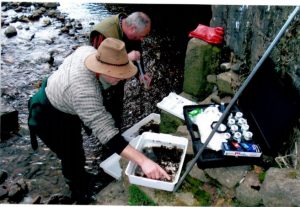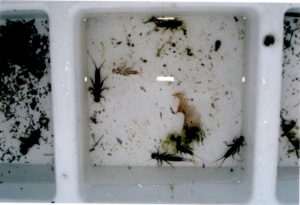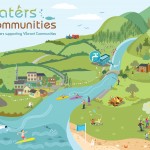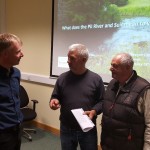In Ireland, we are never far from at least one…
What fly is that?
This is a question that has puzzled anglers from all around the world and one that ensures the constant pitting of wits between nature and those who fly fish. The ability to identify which flies are attracting trout and the ability to then recreate them can allow the angler to win that very battle of wits between man and nature, even if it is just once in a while.

Martin and Willie examining a kick sample
Two such anglers are Martin Ryan and Willie Bryan, both are members of ‘Clonmel and District Salmon and Trout Anglers Association’ and ‘Cashel, Golden, Tipperary Anglers Association’. Between them they have over ninety years’ experience fishing the rivers streams and lakes of Waterford, Tipperary and the great lakes of the west of Ireland. They have gained a vast knowledge of river flies through years of experience and from numerous angling publications, books and magazines.
While many trout anglers are capable of identifying some of the insects which live in the rivers and stream in which they fish, most do so from a historic or anecdotal basis rather than from a scientific one. As fly-tiers, anglers often design flies and imitate natural patterns to represent certain flies, sometimes without knowing whether these flies are even present in our rivers, streams or lakes. Selecting a fly based on the knowledge that the very species is living in our waters makes for more precise preparation and this can give the angler a sporting advantage.
But these tiny insects are more than just the subject of fly fishing folklore, they are a vital link in the chain of life within our freshwater ecosystems. Furthermore, the range and abundance of flies present are clear indicators of the health of any river, stream or lake.
Over the years Martin and Willie developed a keen interest in the identification of river flies and together decided to take this interest a step further by undertaking a study of water habitats in Waterford City and County and to record the range and numbers of flies they found. They called this project ‘The Waterford Ephemeroptera (Mayfly) and Plecoptera (Stonefly) Recording Scheme’ or WEPRS and it ran from January to September 2010. The scheme received the support of the National Biodiversity Data Centre in Waterford; Mary Kelly-Quinn of UCD; and Craig Macadam of the British Ephemeroptera Recording Scheme. Funding was secured from the Heritage Council through Bernadette Guest, Heritage Officer, Waterford City and County Council, and this covered the cost of sampling equipment and travel expenses.
- Total number of sites visited during the survey = 82
- Number of insects collected = Over 22,000, from which approx. 3,500 were retained for positive identification.
- Samples were collected from sites at altitudes ranging from sea level to 502 metres above sea level.
- Total mileage accrued from January – September 2010 = 12,000 miles.
The methods used to collect samples of immature Mayfly and Stonefly nymphs for the survey are those approved by the EPA and the British Ephemeroptera Recording Scheme. Standard kick sampling techniques were used to collect the nymph samples for the survey. This involves the use of a 1mm mesh net placed downstream of the chosen sample area while the substrata immediately upstream are agitated to dislodge any species present.
The insects collected are then placed into a sorting tray for examination and separation into the different family groups. A selection of the samples collected by Martin and Willie were placed into an alcohol solution for transportation to the laboratory at the National Biodiversity Data Centre for closer examination and identification. The vast majority of samples gathered were released back to the waters they were collected from, thus ensuring minimal disruption to the natural habitat.
In addition to kick sampling, stone washing was used to dislodge the stone clinging nymphs for collection and examination. The collection of adult flies of Ephemeroptra and Plecoptera was carried out using a sweep net of 1 mm mesh. The net when drawn through bankside vegetation dislodges the winged insects into the net. When identification was made at waterside the species were recorded and the insects then released, in instances where closer examination and identification was required the sample was placed into a plastic container for transportation to the lab. On most of the waters surveyed, at least three sites were sampled and where possible a distance of five kilometres was spaced between each site.

Samples of Stoneflies
Results from the WEPRS 2010 were compared to existing publications for verification and to assess the true value of the study. Comparisons on the mayfly species encountered was made with the findings of ‘The Distribution of the Ephemeroptra in Ireland’ by Mary Kelly-Quinn and John J. Bracken (2000) and the ‘Mayflies of County Waterford’ by Michael O’Meara (2008).
The WEPRS identified 22 species of Ephemeroptra (mayflies), this number includes 6 previously unrecorded species for Waterford. In addition, 12 species of Plecoptera (stoneflies) were recorded.
It is important to note that Martin and Willie had no scientific background when they set out on this study. What they did have was a knowledge of their local waters from an angler’s perspective and this proved invaluable to them. By carrying out this study of river flies the two anglers not only discovered the variety of species living in their local waters but also gained a greater understanding of the importance of these insects to the very survival of trout and salmon in our waters.
Perhaps it is the Latin terminology used by scientists to name these flies, such as Brachyptera risi (February Red) that deters more anglers from taking a closer look at the range of insects living in their rivers. Perhaps most anglers are content to rely on the knowledge of others and anecdotal evidence to determine their choice of fly. Martin and Willie list the benefits to anglers of having a greater understanding of the different species of flies in our waters as follows:
“You become a more informed angler, able to make a better choice of fly and more skilled at tying flies as a result of the knowledge gained.”
“You become more aware of the importance of these insects to the overall health of the river, stream or lake.”
“You can create a benchmark which will indicate any future improvements or deterioration in water quality of the waters you fish.”
“If there are young members of a club or group who have an interest in science and biodiversity, this type of study caters for such interests and can provide opportunities for a career arising out of a hobby.”
Since completing the report on Waterford’s Mayflies and Stoneflies in 2010, Willie Bryan has completed a certificate in Biological Identification and Recording at UCD. Willie and Martin see both a challenge and opportunity for angling clubs to take on similar studies in their waters and to be more aware of the significance these insects have for the survival of salmon and trout in our waters.
Both Martin and Willie recently attended a ‘Waters and Communities’ public meeting at Kildalton College, Piltown, Co. Kilkenny to discuss local opportunities and issues relating to the Pil River and the River Suir. After the meeting the pair got chatting with Dr Fran Igoe about river flies and put forward a proposal to undertake a similar study along the Pil River, this study would prove valuable as the ecological status of Pil River has not yet been assigned. This will be of benefit to the local communities who wish to gain a better understanding of the life in and along their local river. At that meeting Martin and Willie also met with a group from the ‘Friends of St Johns River’ in Waterford City and agreed to carry out an up-to-date study of the river flies in that river for comparison to their WEPRS 2010 study. The two anglers are willing to offer similar support and advice to any angling club or group wishing to take on such an interesting and rewarding project.
As to the original question “What fly is that?” – we may not know the answer, but we now know who to ask – Martin Ryan and Willie Bryan.
‘I would like to congratulate Martin and Willie on the important contribution they are making to recording and monitoring of fly life in our rivers. They have acquired an expert knowledge of mayfly and stonefly identification and clearly illustrate the enormous potential contribution that citizen science can make. Many mayfly and stonefly species are under threat and we need up-to-date information on their distribution. This is a challenge with 74,000 km of river channel in Ireland, most of which is small headwater streams which are especially important from a biodiversity perspective. We need more citizen scientists like Martin and Willie to engage in recording and tracking changes in fly life in their local rivers and streams.’ – Mary Kelly- Quinn, Associate Professor, School of Biology & Environmental Science, UCD.
Article by Martin Ryan, Willie Bryan (Anglers and Fly Experts) and Alan Walsh, Local Authority Waters and Communities Office

Martin and Willie at an angler’s hut







